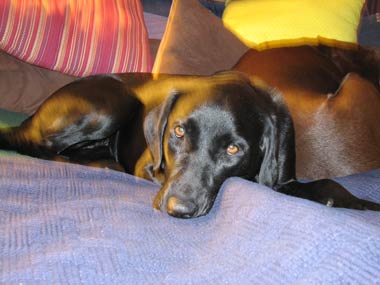
The Cynodictis Project
This is an on-going journal about the 14,000 year-plus shared journey of primates and canines.
Learn about the alien intelligence that's snoozing on your rug right now.
Find out what we've done to them (and what they've done for us) in the planet's longest-running genetic experiment.
To read all the postings in The Cynodictis Project, click on the header 'Canine' in the gray navigation bar above.
If you find the information presented here in The Cynodictis Project of some value, please consider donating to help defer our expenses. All monies received will be used for the purchase of kibble. Thank you.
Recent Posts
- Huxley’s gait, Sunday, November 11, 2012 – Three Months of White Crane Formula Hip Guard – Herbal Supplement Treatment
- 3D Photos – Zombie Walk – October 26, 2012
- Zombie Walk/Pub Crawl – October 26, 2012 for the Stratford Dog Park
- Your Tax Dollars at Work: Federal Agency’s $2.5 Billion Art Project
- Huxley’s Gait – August 7, 2012 – Backyard to Side Door before Pubescent Angelica Root
The Cynodictis Project
The topic is dogs and nothing is off limits.
Lord Reith, born John Reith, was the founder of the BBC and public television broadcasting in England. A man of many firmly held opinions, he once said, “There are some people whom it is one’s duty to offend.”
- History, opinion, and the shocking true facts “they” don’t want you to know about canis lupus familiaris.
- Did dogs fly space ships? Sure, the earliest one’s, at least. But they were strictly one-way trips.
- What kind of color vision is it that dog’s have anyway? It’s not B&W.
- “On the Internet, nobody knows you’re a dog.” from the cartoon by Peter Steiner, page 61 of July 5, 1993 issue of The New Yorker.
“The dog has advantages in the way of uselessness as well as in special gifts of temperament. He is often spoken of, in an eminent sense, as the friend of man, and his intelligence and fidelity are praised. The meaning of this is that the dog is man’s servant and that he has the gift of an unquestioning subservience and a slave’s quickness in guessing his master’s mood. Coupled with these traits, which fit him well for the relation of status — and which must for the present purpose be set down as serviceable traits — the dog has some characteristics which are of a more equivocal aesthetic value. He is the filthiest of the domestic animals in his person and the nastiest in his habits. For this he makes up in a servile, fawning attitude towards his master, and a readiness to inflict damage and discomfort on all else. The dog, then, commends himself to our favor by affording play to our propensity for mastery, and as he is also an item of expense, and commonly serves no industrial purpose, he holds a well assured place in men’s regard as a thing of good repute. The dog is at the same time associated in our imagination with the chase — a meritorious employment and an expression of the honorable predatory impulse.”
“Standing on this vantage ground, whatever beauty of form and motion and whatever commendable mental traits he may possess are conventionally acknowledged and magnified. And even those varieties of the dog which have been bred into grotesque deformity by the dog-fancier are in good faith accounted beautiful by many. These varieties of dogs — and the like is true of other fancy-bred animals — are rated and graded in aesthetic value somewhat in proportion to the degree of grotesqueness and instability of the particular fashion which the deformity takes in the given case. For the purpose in hand, this differential utility on the ground of grotesqueness and instability of structure is reducible to terms of greater scarcity and consequent expense. The commercial value of canine monstrosities, such as the prevailing styles of pet dogs both for men’s and women’s use, rests on their high cost of production, and their value to their owners lies chiefly in their utility as items of conspicuous consumption. Indirectly, through reflection on their honorific expensiveness, a social worth is imputed to them; and so by easy substitution of words and ideas, they come to be admired and reputed beautiful. Since any attention bestowed on these animals is in no sense gainful or useful, it is also reputable; and since the habit of giving them attention is consequently not deprecated, it may grow into an habitual attachment of great tenacity and of a most benevolent character.”
-Thorstein Veblen, The Theory of the Leisure Class, An Economic Study of Institutions, 1899
